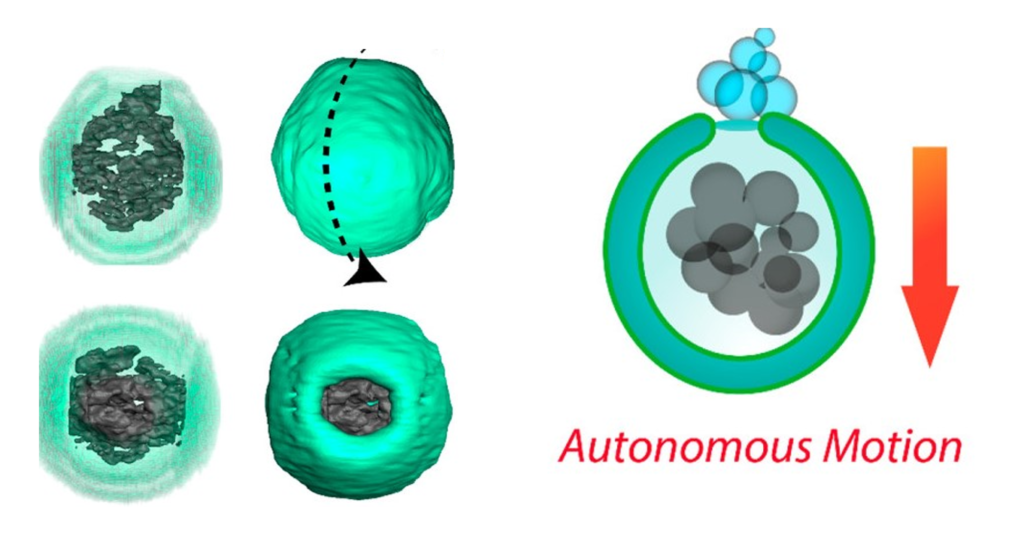
An emerging area in biomedicine that is currently being explored is the use of motorized, biocompatible and biodegradable particles that shuttle drugs to diseased tissue. Nanomotors are molecular or nanoscale devices that can move through a biological medium by converting chemical energy into motion and can be used for the delivery of pharmaceutical drugs to specific parts of the body. Now researchers from the Institute for Complex Molecular Systems (ICMS) at Eindhoven University of Technology (TU/e) along with researchers from the Institute for Bioengineering of Catalonia (IBEC), the Soochow University and Swansea University have developed a new synthesis approach for biodegradable nanomotors where inorganic nanoparticles stored in the nanomotors help to propel the nanomotors. This study has been published in the journal Nano Letters.
Innovative nanomotor
The innovative hybrid nanomotor is composed of a structure called a stomatocyte, also known as poly(ethylene glycol)-block-poly(D,L-lactide) (PEG−PDLLA), which is loaded with manganese dioxide – the engine for the nanomotor. The PDLLA block copolymer stomatocytes are bowl-shaped cells and have a hollow inner cavity with a small opening to the external environment. Previous research had demonstrated the ability of these particles to confine and protect and engine or fuel within the cavity, which can then be catalyzed to drive movement through complex biological environments. As a proof-of-principle, researchers demonstrated effective tumor penetration of the hybrid nanomotors, showing that these engineering nanomotors can retain their functionality within biological contexts and they show a potential for biomedical applications.
Engine synthesized in the nanomotor
The present work offers a novel approach where the manganese dioxide engine is synthesized inside the stomatocyte nanomotor. When this inorganic-based engine reacts with hydrogen peroxide, it creates nanobubbles of oxygen that are expelled from the small opening of the stomatocyte, and thus propels the structure in the opposite direction. Hydrogen peroxide, which is toxic to cells, is highly expressed in tumor microenvironments. The stomatocytes can also be reused once the engine inside their cavity remains functional, and if not in use, the engine does not “escape” from the opening even after a period of three months.
The hybrid structure described is fully biocompatible and biodegradable, owing to its organic exterior. Moreover, the nanomotors described could be employed as multimodal platforms and there is potential to control the particles remotely with external cues (for example magnetic fields or light). In other words, these new hybrid compounds exhibit the best features of inorganic and organic nano-architectures. This study paves the way for further exploration of autonomous nanomotors and their numerous potential applications in biomedicine.
About ICMS-IBEC collaboration
IBEC and ICMS planted the seed of what has thus far been a promising partnership in 2018, and in 2020, both institutions signed a new collaboration agreement. Currently, two IBEC group leaders, Vito Conte and Lorenzo Albertazzi, have dual appointments with ICMS. Here you can read more about recent IBEC-ICMS scientific collaboration regarding multi-responsive molecules able to self-assemble and a review about how artificial systems imitate how cells move and communicate.
Reference article:
Imke A. B. Pijpers, Shoupeng Cao, Antoni Llopis-Lorente, Jianzhi Zhu, Shidong Song, Rick R. M. Joosten, Fenghua Meng, Heiner Friedrich, David S. Williams, Samuel Sánchez, Jan C. M. van Hest, and Loai K. E. A. Abdelmohsen “Hybrid Biodegradable Nanomotors through Compartmentalized Synthesis” Nano Letters. DOI: 10.1021/acs.nanolett.0c01268.





